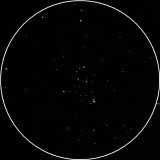
| MESSIER 103 |
|---|
RA: |
01h 33m 12s |
|
DEC: |
+60° 42' 00'' |
|
Type: |
Open cluster |
|
NGC: |
581 |
|
Magnitude: |
7.40 |
|
Surface brightness : |
||
Apparent dimensions : |
6.0'x6.0' |
|
Distance: |
8,500 ly |
|
Open cluster M103 is one of the "latest additions" (together with M101 and 102) to his catalog, which Charles Messier included from Pierre Méchain's report, but had no occasion and no time to observe before publication. Adopting a distance of 8,500 light years, M103's angular diameter of 6 arc minutes corresponds to 15 light-years linear extension. This stellar swarm is approaching us at 37 km/sec. In binoculars, M103 is easy to find and identify, and well visible as a nebulous fan-shaped patch. Mallas states that a 10x40 finder resolves the cluster into stars; however, this is so only under very good viewing conditions. The object is not so easy to identify in telescopes because it is quite loose and poor, and may be confused with star groups or clusters in the vicinity. But telescopes show many fainter member stars. This cluster is quite easy to find from Delta or 37 Cassiopeiae (named Ruchbah), a blue-white 2.7-mag star of spectral type A5 III-IV, 1/2 deg N and 1 deg E, close to the line to Epsilon (Segin; mag 3.38, spectrum B3 III). Situated nearby are a number of other open clusters, including Trumpler 1, NGC 654, NGC 659 and NGC 663. The latter is sometimes mentioned as a candidate to be confused with M103. |
||
VEDRAN VRHOVAC© 2006.-2007. |
